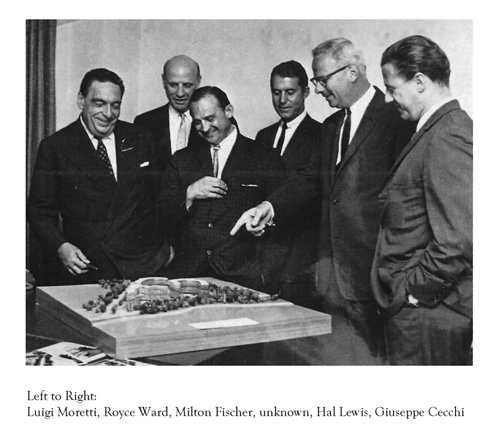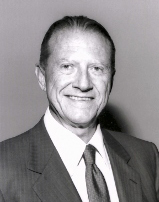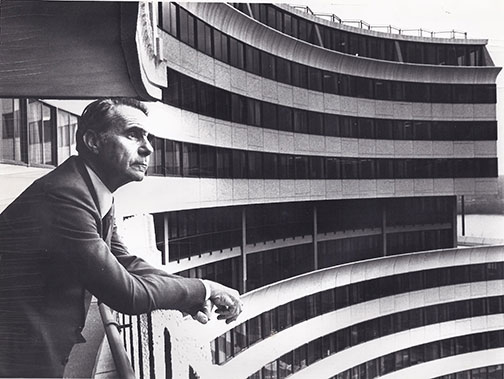 |
Watergate Complex History
The Principal Players
Design, Development, Construction Teams
Home: Overview & Main Index | Press & Media Center | 50th Anniversary Index | Historic Materials & Memorabilia Index |
Design: Architects
Luigi Moretti (Italy)
Milton Fischer (USA)
William Graff, Project Architect
Development & Construction
Sponsor: Watergate Improvement Associates
Aldo Samaritani, Chairman
Nicolas M. Salgo, President
Project Management: Ediltecno, S.p.A., Inc: Giuseppe Cecchi
Interview with Giuseppe Cecchi, Project Manager for the Watergate Complex. 15 Jun 2007. Reprinted with permission from The Italian Legacy in Washington D.C. by Luca Molinari, Skira, 2008.
Financing: John Hancock Mutual Life Insurance Company, arranged by Donald H. Richardson Co., Inc., Byron K. Elliott, CEO
Lighting Consultant: Gerald Ewing
Landscape Architect: Boris V. Timchenko
General Contractor: Magazine Brothers Construction Corp.
Sales/Management Agent: Riverview Realty Corporation - Hal Lewis
Engineer: Royce Franklin Ward (CE) of Hageman-Harris (NY firm)
Structural Engineers: Heinzman & Clifton, Washington DC
Survey Engineers: Matz-Childs & Associates, Rockville, MD
Computer Program: Engineering Physics Co.

Aldo Samaritani (February 27, 1904 - June 11, 1996)
President, Società Generale Immobiliare (SGI).1 Mr. Samaritani hired Moretti as an external consultant for SGI to develop several projects, including Watergate. SGI was the largest Italian real estate and construction company. It was founded in Turin in 1862, moving to Rome in 1870 with the unification of Italy. After moving to Rome, the company became interested in the pastoral land around Rome and ended up buying it. With the growth of Rome, the company grew as real estate prices rose. With time, the company's activities changed from focusing on real estate to focusing on construction. One of the people to lead Immobiliare in the construction direction was Aldo Samaritani who joined the company in 1933. The company is famous for building numerous residential buildings throughout Italy.
Immobiliare's largest share holder was the Vatican, which held fifteen percent of the shares.However, most of the Vatican's holdings in the company were sold in the late 1960s to Gulf and Western.
More on Mr. Samaritani here: Who's Who in Foreign Business (c.1965 - from the Henry Winston scrapbook)
Luigi Moretti, HFAIA (November 22, 19062 - July 14, 1973)
Italian architect Luigi Moretti, a Roman, began his career in the 1930s and specialized in large-scale apartment houses and public spaces. Moretti executed only two projects in North America: the Montreal Stock Exchange Tower in Canada and the Watergate complex in Washington, DC. Moretti is widely considered the most important Italian architect of the 20th century. He produced a massive body of work in the years 1930-1973 in Italy and abroad. He studied at the Royal School of Architecture in Rome, graduating in 1929 with honors. He designed the Watergate project as a consultant for SGI (Società Generale Immobiliare).
In 1957, interest in logic, math and scientific disciplines remerged in Italy. The theory of "parametic architeture" was formalized and presented to the design community in 1960. That year, Moretti began the design of the residential district INCIS at Decima, Rome and the Watergate, showing his interest in the configuration of structural elements and their spatial representation.
The Watergate project resolved the counterpoint between the geometric pattern of the irregular couse of the Potomac river and L'Enfant's grid. Buildings were designed in an amphitheater shape to multiply the vistas and views toward the natural elements. The green areas, set in hollows, offer the sense of a river park. The physical and visual perimeter pulls the city in to the park area.
More Reading
Moretti and his Architecture
The Watergate Project
Summary of presentation by Mario di Valmarana, December 2005
Milton Fischer, AIA (June 25, 1910 - October 2, 1999)
Born in New York City, Milton Fischer was educated at Columbia University from 1929 to 1930, earned his B.S. in Architecture from the University of Michigan in 1933 and followed that with special studies with Henry Wright and also 1933 and 1934 at the Mount Olivet Summer School. During the 1940s he saw government service in the Office of Administration for the U. S. Housing Authority (1942-1944) and then as Director of Urban Development for the Housing Authority (1946-1947). In 1950 he again worked with Henry Wright, but in 1952 he joined Corning & Moore (later Corning, Moore, Elmore & Fischer), architects in Washington, DC. Fischer collaborated with Luigi Moretti on the design for the Watergate apartment complex.
Giuseppe Cecchi (1931 - )
Giuseppe Cecchi came to Washington, DC from Milan, Italy (his home town) in 1960 (at 29 years old) as an employee of SGI (Società Generale Immobiliare), which decided to expand its activities in North America. Mr. Cecchi was to set up a New York City office for SGI. This eventually led to purchase and development of the Watergate complex.
SGI purchased the land and built the Watergate. It took nearly 10 years to complete. Taking advantage of newly enacted zoning laws, Watergate was the first mixed-use planned (PUD) project in the District. When it was finished in 1971, the complex consisted of a hotel, two office buildings and three residential cooperative buildings.
Mr. Cecchi, president of IDI Group Companies, was president of Wateragte Improvements, Inc. and Watergate Construction Corp. He has a masters in Professional Engineering from the University of Milan (1955). He eventually settled in northern Virginia, where he continues to live with his extensive family. Three of his sons work with him at the Rosslyn offices of IDI.
More Reading
Giuseppe Cecchi: The private developer, Mary 20, 2003, by Christine Cubé, Washington Business Journal
"People and Politics: Business Hall of Fame: Giuseppe Cecchi: Pioneer in mixed-use development," November 9, 2012, by Leslie Milk, Washingtonian
Washington Business Hall of Fame - Junior Achievement (video and article)
Washington Business Hall of Fame > 2012 Laureate Biographies > Giuseppe Cecchi
Nicolas M. Salgo (August 17, 1914 - February 26, 2005)
Budapest-born Nicolas Salgo was a founder and limited partner of Watergate Improvement Associates (1960-1977) then chairman of the Watergate Companies (1977-1983), eventually acquiring ownership of the Watergate Hotel. He received an LL.D. and PH.D from the Eötvös Loránd University (Budapest) in 1937. Besides his native Hungarian, he was fluent in English, French and German. In 1959, he established the Salgo Award for teaching excellence. His interest in education resulted in the Salgo Trust for Education (more).
He became a naturalized American citizen in 1953. He was appointed ambassador to Hungary (September 20, 1983) during the Reagan administration (more).

More Reading
New York Times, March 2, 2005, "Nicolas M. Salgo, Who Built Watergate Complex, Dies at 90", Wolfgang Saxon
Washington Post, March 1, 2005,"Nicolas Salgo Dies; Watergate Developer, Ambassador", Adam Bernstein
New York Times, February 26, 1986, "BRIEFING: No Vacancy in Hungary," Wayne King and Warren Weaver, Jr.
University of Texas, Reagan Archives, June 15, 1987, Accordance of the Personal Rank of Ambassador to Nicolas M. Salgo While Serving as Chief of the United States Delegation for Property Negotiations With the German Democratic Republic
William Graff (A.I.A. (1925)
Mr. Graff, born in Budapest, Hungary, and a 1949 graduate of the Hungarian Technical University, who emigrated to the United States in 1954 and was formerly associated with The Architects Collaborative of Cambridge, Massachusetts, during the design of the University of Baghdad in Rome, collaborated with Dr. Luigi Moretti in Rome before he was transferred to Washington as the Project Architect of the Watergate development in 1964. In a January, 2014, interview at his Florida home, Mr. Graff added to the historical record:
"Luigi Moretti developed the conceptual design of the Watergate project. The initial drawings were developed in Rome, first in Moretti's studio, then further developed in the Studio di Architettura Gabor Acs of the Società Generale Immobiliare. As the associate of Gabor Acs since 1962, I led the Studio's designs for SGI's foreign investments, such as the ones in Monte Carlo, Paris, Montreal, Los Angeles, Mexico City and, of course, in Washington the Watergate."
"Ediltecno, a daughter [subsidiary] corporation of SGI, legally oversaw the overseas projects. Count Guido di Carpegna, a dear friend, worked also with me in the Ediltecno in Rome prior to my Washington assignment."
"Nicolas Salgo was considered a financial genius, at one point called the "father of the conglomerates."3
"As Project Architect for the Watergate, I signed all submissions for zoning, building permits and represented the project at the hearings with the various commissions, such as the all-important Fine Arts Commission. At this time it was Charles Atherton who was its very capable secretary. Don Myers, Mrs. Saarinen, Gordon Bunshaft (of Skidmore, Owings and Merrill), and John Carl Warnecke were its members who approved our submission."
As in all other constructions in the "monumental core", Watergate was allowed a total height of 143 feet and 4 inches, to correspond and not exceed the cornice height of the Lincoln Memorial."
"In the fall of 1967 I left the project to start my partnership with Henry C. Holle, Architect.
Since eventually the Holle & Graff partnership designed for IDI (successor of the SGI) the Watergate at Landmark, the Rotonda, the Montebello, the Porto Vecchio and the Belvedere projects in Virginia, two office buildings at Tyson's Corner and some of the Leisure World projects, as well as the VISTA Hotel in Washington, I was happy to be reunited with Giuseppe Cecchi, whose outstanding leadership in the realization of the Watergate Project and expertise in the development of these subsequent projects I would like to acknowledge hereby."
Royce Franklin Ward (1909 - September 20, 1993)
Royce Franklin Ward was a Civil Engineer, graduating from Rensselaer Polytechnic Institute in 1931. He was born in Brooklyn, the son of Charles Ward, a former city Commissioner of Public Works. In 1957, he was elected president of the New York firm of Hegeman-Harris Company, Inc., where he helped developed the Foggy Bottom area of the capital, starting with Washington's first cooperative apartment complex, Potomac Plaza. In 1959, he formed Watergate Improvement, then joined forces with Società Generale Immobiliare of Italy to develop the Watergate apartment, hotel and office complex in Foggy Bottom. The first building, Watergate East, was finished in 1965, and the entire complex was completed 10 years later.
Potomac Plaza
According to Mr. Cecchi, Hegeman-Harris had the rights to build on the land that is now Potomac Plaza. Mr. Salgo, the New York financier, brokered the deal between Hegeman-Harris and SGI to build Potomac Plaza. Mr. Cecchi recalls this was the "test" for proceeding through the District of Columbia's permitting process, before undertaking development of the 10-acre site that is now the Watergate complex. Obviously, the permit process was easy enough that SGI went on to develop the Watergate site -- and the rest is, as they say, history.
Hal Lewis
President, Riverview Realty Corporation, leasing agent for Watergate.
Boris V. Timchenko
Lanscape Architect. More on Mr. Timchenko here.
----------------------
Contact
|
|
|
